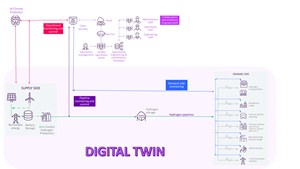Articles
Develop and deploy H2 digital twins
Digital Technologies
R. CALDER, AVEVA, Cambridge, England
Developing cleaner energy options and decarbonizing existing facilities are key challenges facing engineering and operating companies worldwide. Green and blue hydrogen (H2) will play a significant role in this effort, and operating companies are looking for every advantage to optimize existing production and deploy improved production methods, while effectively managing the entire value chain.
Digital technologies are playing a critical role in these endeavors by providing the data sharing, analytics and visualization necessary to accelerate the transition in each area. Design firms and production enterprises must engineer faster, operate more reliably, and meet regulatory and end user demands. Digital technologies improve efforts in these and other areas.
While digital twins may often be thought of as just a run-time optimization tool, a comprehensive digital twin established during conceptual design will also work and deliver value throughout all subsequent project stages. Because a digital twin is a “system of systems” encompassing many digital solutions, it spans all aspects of a H2 asset project lifecycle (FIG. 1). Therefore, a H2 digital twin is positioned to facilitate and accelerate efficiency efforts in all project lifecycle stages for staff working in various roles.

Ensuring reliable operations. H2 production and distribution presents many challenges for operators. Data from multiple disparate systems must be aggregated and visualized. Critical production assets need constant monitoring to ensure they are operating at peak performance and to determine when conditions may compromise functionality or suggest the need for preventive maintenance. In addition, layered leak detection and smart alarms are essential.
To address these and other needs, a digital twin unifies engineering and operational data, combining artificial intelligence (AI) models and other types of analytics with real-time data to increase asset reliability and reduce unplanned downtime. This data-driven approach also enables operators to optimize production and operational expenditures, focusing on minimizing the carbon footprint.
Visualizing live key performance indicators (KPIs) and digital twin results—delivered throughout the organization using a unified operations center—ensures that different users provide consistent information. This approach empowers all users from the plant floor to the upper management to make faster and better decisions.
Executing a digital engineering handover. Some early digital twins were developed strictly for run-time operations, but a modern digital twin is ready to support new green H2 projects, beginning with conceptual design to ensure project feasibility and cost-effectiveness. In addition, it is now possible to develop a digital twin through engineering to evaluate multiple scenarios and operating conditions to provide an optimum design and digitally hand over the project (in the form of a digital twin) to operations, where it will be combined with live data and used in production.
A methodology based on digital engineering enables the validation of process behavior and control strategies related to electrolyzers, wind turbines, solar farms, weather prediction and the electric grid. More efficient engineering enables the most cost-effective design with superior risk mitigation. The digital twin can also be extended for smooth startup and fast ramp-up to total production, maximizing the return on investment.
For example, thyssenkrupp followed a digital engineering approach to green H2 plant design. The 3D visualization enabled the company to optimize the design of the new green H2 plant, increasing operational efficiency, improving collaboration and driving sustainability throughout process design and project execution.
Managing the value chain. H2 production at a single facility is only one part of the larger H2 economy. Production processes for green and blue H2 are only one challenge; it is also difficult to manage a complex system that may include multiple, widespread facilities, each powered in part or whole by renewable electricity subject to weather conditions and related to other functions such as carbon capture, utilization and storage (FIG. 2).

Superior visibility is required to coordinate the multiple parties and systems involved with these types of projects and installations. A unified model is essential for optimally balancing green and blue H2 supply and demand. Making this happen calls for the ability to seamlessly share data across the value chain, providing KPIs through contextual dashboards to different devices and users that need the information.
A successful digital twin improves efficiency across the entire low-carbon H2 industry, making it possible to validate compliance with sustainability, renewable energy, and environmental, social and governance requirements.
Digital twins accelerate the transition to a low-carbon H2 industry. A comprehensive digital twin is a holistic convergence of the data, models, analytics and the user experience (visualization and interaction capabilities) created from it. For the low-carbon H2 industry, a properly implemented digital twin strategy helps enterprises reduce existing facilities' carbon intensity, support the technical advancements necessary to cost-effectively develop and scale new green and blue H2 production, and play a vital role throughout the entire value chain.H2T
NOTES
a AVEVA digital twin
About the author

ROY CALDER is the Industry Principal for New Energies at AVEVA, where he focuses on applying digital twins in the sustainable H2 industry. He has nearly four decades of industrial experience and works to support industry trends in sustainability and the circular economy. Calder earned his BS degree in chemical engineering from the University of Strathclyde in Glasgow, Scotland.

